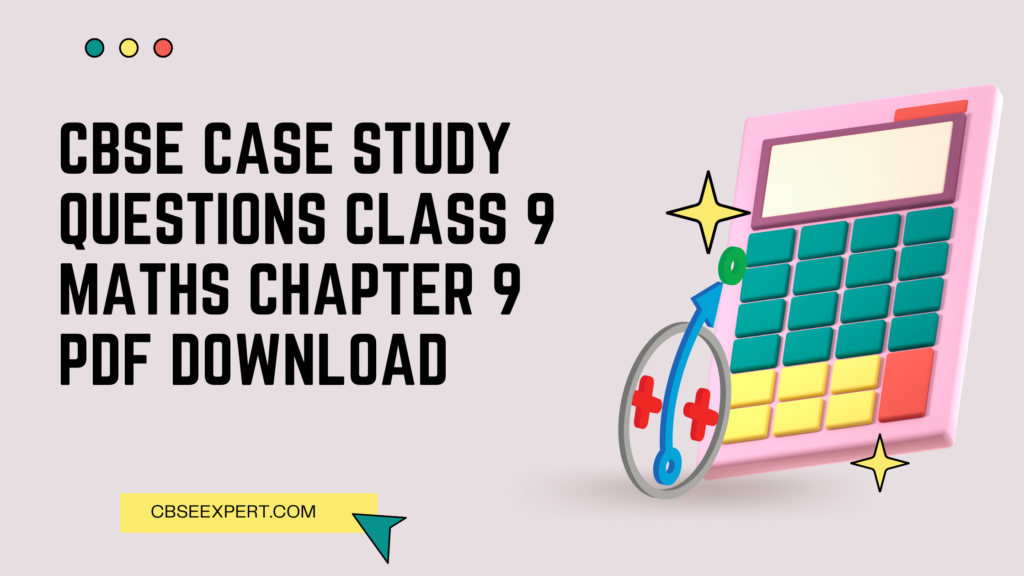CBSE Case Study Questions Class 9 Maths Chapter 9 are very important to solve for your exam. Class 9 Maths Chapter 9 Case Study Questions have been prepared for the latest exam pattern. You can check your knowledge by solving case study-based questions for Class 9 Maths Chapter 9 Areas of Parallelograms and Triangles
Case Study Questions Class 9 Maths Chapter 9
Case Study 1. A group of students is learning about the areas of parallelograms and triangles. They came across the following scenario:
Rahul and Sana participated in a gardening project where they needed to create rectangular plots in their backyard. They made the following observations:
- Rahul’s rectangular plot has a length of 10 meters and a height of 5 meters.
- Sana’s rectangular plot has a length of 12 meters and a height of 6 meters.
- Both plots have the same base and height.
Based on this information, the students were asked to analyze the areas of the parallelograms formed by the rectangular plots. Let’s see if you can answer the questions correctly:
Q1. The area of Rahul’s parallelogram is:
(a) 25 square meters
(b) 50 square meters
(c) 60 square meters
(d) 120 square meters
Answer: (b) 50 square meters
Q2. The area of Sana’s parallelogram is:
(a) 25 square meters
(b) 50 square meters
(c) 60 square meters
(d) 120 square meters
Answer: (c) 60 square meters
Q3. The type of parallelogram formed by Rahul’s plot is:
(a) Rectangle
(b) Square
(c) Rhombus
(d) None of the above
Answer: (a) Rectangle
Q4. The type of parallelogram formed by Sana’s plot is:
(a) Rectangle
(b) Square
(c) Rhombus
(d) None of the above
Answer: (c) Rhombus
Q5. The area of the triangle formed by the diagonal of Rahul’s plot is:
(a) 25 square meters
(b) 30 square meters
(c) 50 square meters
(d) It cannot be determined
Answer: (a) 25 square meters
Case Study 2. A group of students is exploring the concept of the area of parallelograms and triangles. They encountered the following scenario:
Riya and Ravi went on a school trip to a park. They noticed a triangular garden in the shape of an equilateral triangle. They made the following observations:
- Each side of the triangular garden measures 8 meters.
- The height of the triangular garden is 6 meters.
- The garden is divided into two equal parts by a diagonal.
Based on this information, the students were asked to analyze the areas of the parallelograms and triangles formed by the garden. Let’s see if you can answer the questions correctly:
MCQ Questions:
Q1. The area of the triangular garden is:
(a) 12 square meters
(b) 24 square meters
(c) 32 square meters
(d) 48 square meters
Answer: (b) 24 square meters
Q2. The area of each triangular part formed by the diagonal is:
(a) 12 square meters
(b) 16 square meters
(c) 24 square meters
(d) 48 square meters
Answer: (c) 24 square meters
Q3. The type of parallelogram formed by the triangular garden is:
(a) Rectangle
(b) Square
(c) Rhombus
(d) None of the above
Answer: (a) Rectangle
Q4. The length of the diagonal of the parallelogram formed by the triangular garden is:
(a) 8 meters
(b) 12 meters
(c) 16 meters
(d) 24 meters
Answer: (b) 12 meters
Q5. The area of the parallelogram formed by the triangular garden is:
(a) 24 square meters
(b) 32 square meters
(c) 48 square meters
(d) 64 square meters
Answer: (c) 48 square meters

Hope the information shed above regarding Case Study and Passage Based Questions for Case Study Questions Class 9 Maths Chapter 9 Areas of Parallelograms and Triangles with Answers Pdf free download has been useful to an extent. If you have any other queries about Case Study Questions Class 9 Maths Chapter 9 Areas of Parallelograms and Triangles and Passage-Based Questions with Answers, feel free to comment below so that we can revert back to us at the earliest possible.

